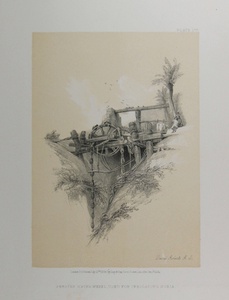| Method | Lithograph with tint stone |
| Artist | after David Roberts |
| Published | London, Published July 15th. 1856, by Day & Son, Gate Street, Lincoln's Inn Fields |
| Dimensions | Image 175 x 125 mm, Sheet 285 x 205 mm |
| Notes |
Plate 177 from Volume 5 of the small format reprint of Roberts' The Holy Land, Syria, Idumea, Arabia, Egypt & Nubia. A view of an elaborate water-wheel in the ancient Egyptian region of Nubia. Irrigation was no less a constant concern for Egyptians in Roberts' day than had been during ancient times. The most popular and enduring solution was the shaduf, a simple counter-levered bucket on a long pole, though numerous other lifts, aqueducts, and waterwheels were also used. Muhammad Ali Pasha had made attempts to modernise Egypt's water supply, and had received submissions from a number of European engineers, including the adventurer Giovanni Belzoni. In Roberts' view, a platform spans a steep ravine with a wheel at the centre, upon which numerous urns have been attached to cables. To the right, a pair of workers stand under a palm, nearby a pair of oxen tethered to the crank that turns the wheel. David Roberts RA (24th October 1796 – 25th November 1864) was a Scottish painter. He is especially known for a prolific series of detailed prints of Egypt and the Near East produced during the 1840s from sketches made during long tours of the region (1838-1840). This work, and his large oil paintings of similar subjects, made him a prominent Orientalist painter. He was elected as a Royal Academician in 1841. The firm of Day & Haghe was one of the most prominent lithographic companies of the nineteenth-century. They were also amongst the foremost pioneers in the evolution of chromolithography. The firm was established in 1823 by William Day, but did not trade under the moniker of Day & Haghe until the arrival of Louis Haghe in 1831. In 1838, Day & Haghe were appointed as Lithographers to the Queen. However, and perhaps owing to the fact that there was never a formal partnership between the two, Haghe left the firm in the 1850's to devote himself to watercolour painting. The firm continued as Day & Son under the guidance of William Day the younger (1823 - 1906) but, as a result of a scandal involving Lajos Kossuth, was forced into liquidation in 1867. Vincent Brookes bought the company in the same year, and would produce the caricatures for Gibson Bowles' Vanity Fair magazine, as well as the illustrations for Cassells's Poultry Book, amongst other commissions. Condition: Light foxing to margins, not affecting image. |
| Framing | unmounted |
| Price | £25.00 |
| Stock ID | 39155 |

